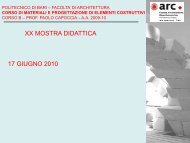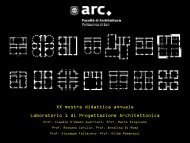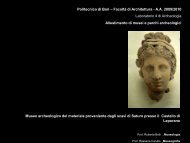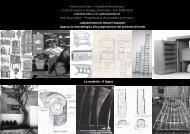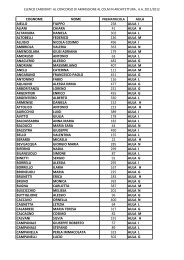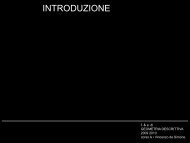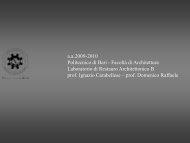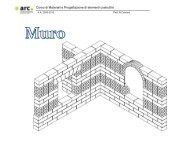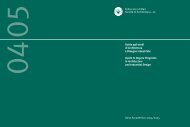Scarica il file pdf - Politecnico di Bari
Scarica il file pdf - Politecnico di Bari
Scarica il file pdf - Politecnico di Bari
Create successful ePaper yourself
Turn your PDF publications into a flip-book with our unique Google optimized e-Paper software.
EtruscologiaEtruscologyL-ANT/07 - 4 cfu2° anno / Corso semestralein<strong>di</strong>rizzo ‘classico’Area <strong>di</strong>dattica XII:Discipline integrative <strong>di</strong> cultura umanisticaMarina MicozziFinalità e contenuti <strong>di</strong>sciplinariObiettivo primario del corso è fornire glistrumenti metodologici necessariall’inquadramento dei principali aspettidella storia, della società e della culturaartistica degli Etruschi.La conoscenza degli eventi storici salientinell’ambito delle principali civ<strong>il</strong>tà del bacinodel Me<strong>di</strong>terraneo nel corso del primom<strong>il</strong>lennio aC, insieme al correttoinquadramento geografico <strong>di</strong> eventi eluoghi, costituisce, quin<strong>di</strong>, <strong>il</strong> presuppostofondamentale per la comprensione dellerealizzazioni artistiche del periodo in esame.L’appren<strong>di</strong>mento teorico riguarda le fasiprincipali della civ<strong>il</strong>tà etrusca dalla primaetà del ferro alla romanizzazione, laconoscenza della documentazionearcheologica, la comprensione dei legamidell’arte etrusca con l’arte della Grecia edel vicino Oriente.La componente applicativa consiste nellalettura ed interpretazione delladocumentazione archeologica ed epigraficafinalizzata alla comprensione dellinguaggio formale dell’arte etrusca eall’appren<strong>di</strong>mento dei fondamenti dellalingua etrusca..Aims and contentsPrimary course objective is to supply thenecessary and methodological instrumentsto comprehend the main themes of theEtruscan history, society and artisticculture.The knowledge of the main historicalevents in the Me<strong>di</strong>terranean areathroughout the first m<strong>il</strong>lennium, togetherwith a correct geographical location ofevents and ancient sites, constitutes thefundamental prerequisite for a correctinterpretation of the artistic realizations ofthe examined period.The theoretical learning concerns theprincipal phases of the Etruscan historyfrom the Iron Age to the Roman conquest,the knowledge of the archaeologicaldocumentation, the comprehension of therelationships between the Etruscan art andthe artistic tra<strong>di</strong>tion of Greek and NearEastern areas.The applications concern the rea<strong>di</strong>ng an<strong>di</strong>nterpretation of archaeologicalmonuments and epigraphic documentation,for a more complete understan<strong>di</strong>ng of theEtruscan art and a basic knowledge of theEtruscan language.Argomenti delle lezioniLa storia e la documentazione archeologicaetrusca dall’età del ferro allaromanizzazione.La questione delle origini: fonti letterarie edati linguistici – La cultura v<strong>il</strong>lanoviana – Ilcontatto con <strong>il</strong> mondo greco – Società ecultura artistica in età orientalizzante – Ilperiodo arcaico e la thalassocrazia etrusca:relazioni commerciali e conflitti politici –Urbanistica e architettura nei centri urbani– La scultura e la pittura tombale – La ‘crisi’del V secolo - L’Etruria costiera e l’Etruriainterna. – La recezione dell’arte classica. –La ‘rinascita’ <strong>di</strong> IV secolo e le lotte conRoma. – L’artigianato artisticoIl pensiero scientifico e religioso. – Le<strong>di</strong>vinità <strong>di</strong> culto – Il sistema cosmico el’organizzazione dello spazio - I santuari: lestrutture architettoniche, i programmidecorativi e le pratiche cultuali nei santuarietruschi tra arcaismo e primo ellenismo.TopicsEtruscan history and archaeologicaldocumentation from the Iron Age to theRoman conquest.The origins of the Etruscans: literary sourcesand linguistic arguments - The V<strong>il</strong>lanoviansand the origin of the city – The contacts withthe Greek world - Society frame and artisticrealizations in the Orientalizing period – TheArchaic period and the Etruscan rule over thesea: commercial relationships and politicalconflicts – Urban planning and architecture inthe Archaic cities – Sculpture and tombpainting – The ‘Fifth Century crisis’ – TheEtruscan cities on the shore and the regions ofthe interior – The contacts with the Greekclassical art – The fourth century revival andthe struggles against Rome – The Hellenisticart and artistic craftsman.The Etruscan scientific and religious thoughts.The Etruscan Pantheon – Cosmography andspatial organization – The sanctuaries: thecult bu<strong>il</strong><strong>di</strong>ngs, the architectural decorationand the rituals, from the Archaic to theHellenistic period.Articolazione delle attività <strong>di</strong>datticheL’attività <strong>di</strong>dattica si articolerà in lezioni,destinate ad affrontare la materia in formarigorosamente <strong>di</strong>acronica; esercitazionibibliografiche, volte ad acquisire glistrumenti e la metodologia necessari acondurre ricerche bibliografiche, e d<strong>il</strong>ettura <strong>di</strong> un contesto archeologicofinalizzate ad una più compiutacomprensione del linguaggio formale edell’articolazione dell’arte etrusca; visite <strong>di</strong>istruzione, destinate ad integrare conl’esperienza <strong>di</strong>retta le cognizioni teoricheacquisite nell’ambito del corso.Articulation of educational activityThe educational activities are articulated inlectures in <strong>di</strong>achronic form, interpretingexercises of an archaeological context for amore complex understan<strong>di</strong>ng of the formallanguage and articulation of the Etruscanart, bibliographical exercises to acquire thetools and necessary methodology to carryout bibliographical searches, educationaljourneys, intended to integrate with <strong>di</strong>rectexperience the theoretical knowledgeacquired within the course..Iscrizione al corsoLe iscrizioni avvengono obbligatoriamentesulla piattaforma entro i primi <strong>di</strong>eci giornidall’inizio dei corsi.Modalità d’esamePer sostenere l’esame è necessaria lafrequenza del corso che consentel’acquisizione dei cre<strong>di</strong>ti previsti: talefrequenza verrà r<strong>il</strong>evata nei mo<strong>di</strong> e nelleforme che <strong>il</strong> docente riterrà più opportuni.44.2.9 Progetti <strong>di</strong>dattici del I ciclo del CdLm in Architettura91




